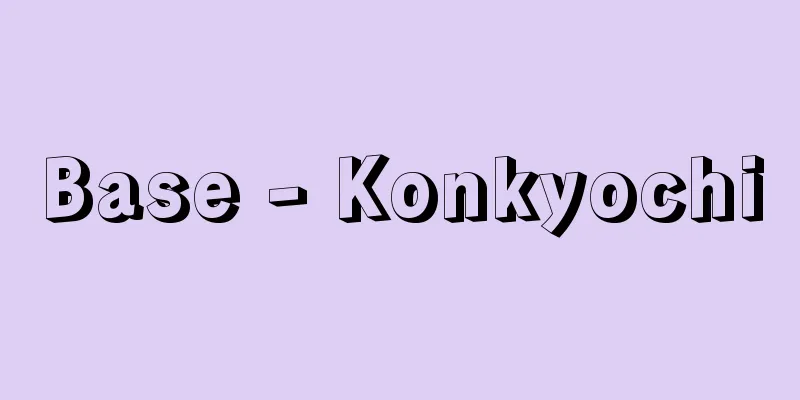Polished rice - Seimai

|
The process of removing the outer bran layer and germ from brown rice to make white rice. This is also called polishing or pounding. Polished rice, which is made by polishing brown rice, is also called polished rice. The bran layer of brown rice contains fiber that is difficult to digest, and the outer layer is colored dark gray or brown, making it dirty when cooked, and the taste is poor if the bran layer or germ is still attached. Removing the bran layer and germ improves these defects and increases the value of the product as a product. However, the bran layer and germ contain more vitamin B1 , protein, and fat than the inner tissues, and fiber has health benefits such as preventing constipation, so it is said that eating polished rice without these components is problematic in terms of nutrition and health. For this reason, rice that is not completely polished, such as 70% polished rice or 50% polished rice, or rice with germ left in, is considered a health food. Nowadays, when side dishes are abundant and people can get enough nutrition from them, fully polished rice, which has excellent taste and appearance, is commonly eaten. In the past, rice polishing was done by pounding brown rice placed in a mortar with a pestle, hence the name 'tsukisei', but nowadays it is done with a rice polishing machine, using methods such as friction, cutting and peeling of the grains through collision. The degree of polishing is expressed as the percentage of the brown rice weight that the polished rice is. The polishing ratio is usually 92-94% for fully polished rice. In sake brewing, rice used as an ingredient for sake is polished to remove a large amount of the endosperm starch-storing tissue further inside the bran layer, so the polishing ratio is less than 70%. [Hoshikawa Kiyochika] [Reference item] |Brown rice: Unhulled rice with the husk removed. 70% polished rice: Rice with 70% of the germ and bran layer removed during polishing removed. Polished rice: Rice with the germ and bran layer completely removed. *All photos are of non-glutinous rice ©Shogakukan "> Types of rice kernels Source: Shogakukan Encyclopedia Nipponica About Encyclopedia Nipponica Information | Legend |
|
玄米の外層の糠(ぬか)層および胚(はい)(胚芽)を除去して白米にすること。精白あるいは搗精(とうせい)ともいう。また玄米を精米した精白米のことも精米という。玄米の糠層には消化しにくい繊維が含まれ、また外層は暗灰色や褐色など着色があり、料理した場合も汚く、それに糠層や胚がついていると味もよくない。糠層や胚を除くとこれらの欠点が改善され、商品としての価値も高くなる。しかし糠層や胚にはビタミンB1やタンパク質、脂肪などが内部組織より多く含まれ、また繊維質は便秘を防ぐなど健康に効果があるので、これらを除いた精白米の常食は栄養・保健的に問題があるといわれる。そこで完全には精白しない七分搗(しちぶづ)き米(まい)や五分搗き米、あるいは胚を残して搗いた胚芽米などが健康食品とされる。副食品が豊かになり、それらから栄養を十分にとれるようになった現在では、味と美観の優れる完全精白米が一般に食べられている。 精米は昔は臼(うす)に入れた玄米を杵(きね)で搗いて行ったので搗精というが、いまでは精米機により、粒の摩擦、切削、衝突による剥離(はくり)などの方法で精米が行われる。搗精した精米の重量が玄米重量の何%にあたるかをもって精白の程度を表し、これを精白歩合という。精白歩合は完全精米の場合、普通92~94%である。清酒原料とする酒造精米では、糠層よりさらに内側の胚乳デンプン貯蔵組織をかなり除去するので、精白歩合は70%未満である。 [星川清親] [参照項目] |玄米:籾(籾米)から籾殻を除いたもの七分搗き米:精白によって除かれる胚芽と糠層部分の70%を除いたもの精白米:胚芽と糠層を完全に除いたもの※写真はすべて粳米©Shogakukan"> 米の穀粒の種類 出典 小学館 日本大百科全書(ニッポニカ)日本大百科全書(ニッポニカ)について 情報 | 凡例 |
<<: Orthomagmatic deposit - Orthomagmatic deposit
Recommend
Tuvalu (English spelling)
Located just south of the equator in the Southern...
state crime
...A political crime means that an act aimed at r...
Identical twins
...The frequency of multiple births is expressed ...
Bienne
...Population: 51,000 (1996). Located on the bord...
Cube root - Rippoukon (English spelling) cubic root
For a real number a , a real number x such that x ...
Selēnē (English spelling) Selene
… She was also the goddess who shot long-range ar...
The words of Anekoji Morotoki
...Hida kokushi family. One of the three kokushi....
Poporo Incident - Poporo Incident
This incident occurred on the campus of the Unive...
Acylurea
...Ureide in English. Also known as acylurea. Mon...
《Mechanical Engineering Glossary》
…In 1907, he participated in the founding of the ...
Sappu Genki - Sappu Genki
Title of a Chinese book. Wang Qinruo, Yang Oku an...
Acetoacetic acid - Sweat and Sakusan
It is an unstable liquid acid with a melting poin...
Via lactea (English spelling) Vialactea
...This hormone is secreted not only when the nip...
Confectionery stamps - Kashi no Kitte
...Soba stamps probably started around the end of...
Cardinal Tetra
… 【kinds】 Next, let's look at the characteris...









